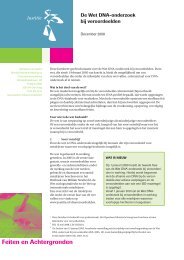INTERPOL HANDBOOK ON DNA DATA EXCHANGE AND PRACTICE
INTERPOL HANDBOOK ON DNA DATA EXCHANGE AND PRACTICE
INTERPOL HANDBOOK ON DNA DATA EXCHANGE AND PRACTICE
Create successful ePaper yourself
Turn your PDF publications into a flip-book with our unique Google optimized e-Paper software.
• Fingernail clippings or scrapings: may contain skin cells or blood of the perpetratortransferred during the attack.• Pubic hair combings: transfer of foreign pubic hair.• Victim’s clothing:• Underwear: <strong>DNA</strong> from seminal fluid or epithelial cells• Outer clothing: <strong>DNA</strong> from possible body fluids and the presence of other traceevidence ( e.g. fibres).• Personal belongings: may be relevant to assessment of identity or the criminalinvestigation.Separate medical examination kits must be used for each individual. Preferably, themedical examinations will not occur concurrently, but will be sufficiently separatedin time and space. Again, this is to eliminate the possibility of cross-contamination viaa third party or shared examination facility. The medical examination kit will containexplicit examination instructions and a medical examination form which should becompleted at each examination. This kit will address the provision of a reference samplein addition to the crime stains from the victim/suspect. It is important that, from thedescription of events provided by the victim, consideration is given to the possibledeposition of <strong>DNA</strong> from those events. For example, if a victim says the attacker kissedhim/her on the neck, then that provides a good reason to make an examination andswab of that area to attempt to locate the perpetrator’s <strong>DNA</strong>.The swabs taken from the victim or suspect should not be stored in transfer media(as is the case for microbiological analysis). This will destroy the <strong>DNA</strong>.The large sheet of paper can be used to catch any trace evidence that may fall from thevictim’s body or clothing during the analysis. This item should be folded carefully andsubmitted with the remaining exhibits.Reference Sample KitA <strong>DNA</strong> reference sampling kit contains at least the following items:• Documented check-list, sampling instructions and guidance• Sterile sampling system for taking buccal cells, blood or hairs• Uniquely numbered and/or bar-coded seals, forms and sample containers• Pairs of disposable gloves• 1 x tamper evident bag/container (for return of sample)Any individual taking a reference sample must wear the gloves provided throughout thewhole sampling procedure. Once the sampling kit has been opened, he should ensurethat the kit is complete by checking off each item against the check-list provided. Afterthis the procedure should be followed according to the sampling instructions.It is important to note that often the sampling instructions contain proceduralrequirements that must be followed under the <strong>DNA</strong> sampling legislation. For thisreason, they must be followed with care and precision as any deviation from theprocedure can lead to the reference sample not being admissible in court proceedings,as has happened in the past.PAGE 26<strong>DNA</strong> SAMPLING<strong>AND</strong> EVIDENCE COLLECTI<strong>ON</strong>







